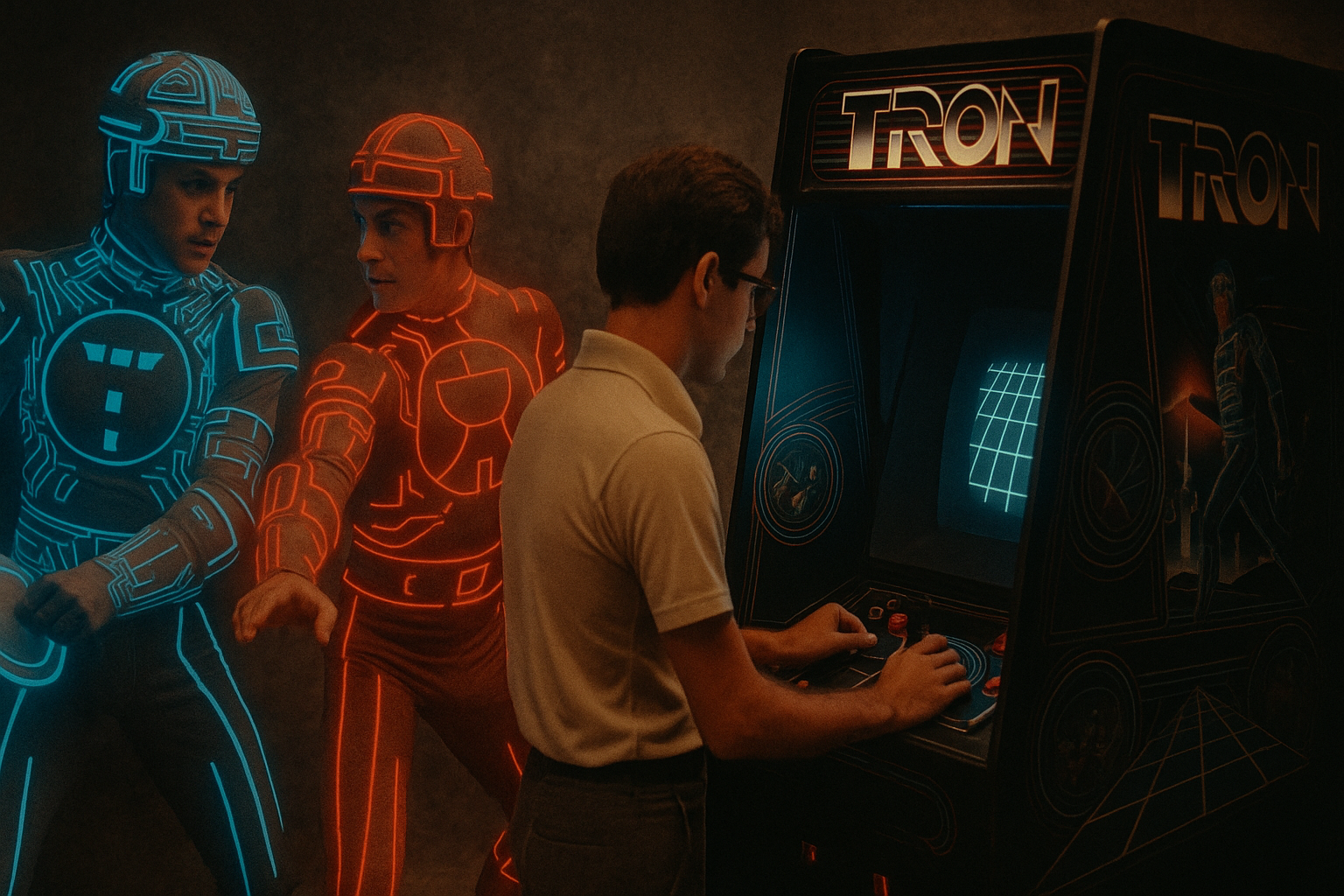Neon Futures and Digital Frontiers: How Disney’s TRON Brought Arcades to the Silver Screen
When gamers picked up the July 1982 issue of Electronic Games Magazine, they weren’t just reading another strategy guide or review column. They were witnessing a cultural turning point—the moment when the world of arcade machines and home consoles collided with Hollywood’s vision of the future. This particular issue carried an exclusive preview of Disney’s TRON, a groundbreaking film that fused video game aesthetics, computer-generated imagery, and arcade culture into a cinematic spectacle unlike anything audiences had seen before.
For readers in 1982, this wasn’t just entertainment journalism. It was proof that the arcade revolution had grown so massive, so influential, that even major film studios like Disney were building entire movies around the culture of video games.
The summer of 1982 marked the peak of the Golden Age of Arcades. Across the United States and beyond, teenagers were pumping quarters into machines like Pac-Man, Donkey Kong, Defender, Centipede, and Space Invaders. Arcades weren’t just game rooms—they were social hubs, competitive arenas, and symbols of youth culture.
Meanwhile, home consoles like the Atari 2600, Intellivision, and Odyssey² were bringing pixelated entertainment into living rooms, fueling a booming market that was on the edge of both explosive growth and impending collapse (the infamous video game crash of 1983 was just a year away).
Amid this backdrop, Electronic Games Magazine—founded in 1981—stood as the first publication to take video games seriously. It wasn’t just cataloging high scores or arcade gossip; it treated games as cultural artifacts, technological innovations, and a new form of storytelling.
The July 1982 issue was especially significant because it previewed Disney’s TRON, a film that would not only borrow from the aesthetics of arcade games but also feed back into them—spawning arcade cabinets, home console tie-ins, and influencing the very language of digital culture.
The feature article, “The Coming of TRON,” gave readers an inside look at Disney’s daring attempt to merge the neon-lit energy of the arcade with the epic scope of science fiction cinema.
The article explained how the movie’s protagonist, Kevin Flynn (played by Jeff Bridges), a computer programmer and arcade owner, is pulled inside a digital world where he must battle rogue programs in gladiatorial-style competitions that resemble arcade classics. The magazine described Disney’s innovative production techniques, which used backlit photography, blue-screen effects, and pioneering computer-generated imagery (CGI) to create a world that looked like a living arcade game.
For gamers who lived and breathed the glow of CRT screens, this was validation: video games weren’t just a hobby—they were becoming the foundation of mainstream pop culture.
The cover of the July 1982 issue of Electronic Games was as striking as the feature inside. It placed TRON’s glowing warriors against a backdrop of digital landscapes, their bodies lit in electric blue and red, echoing the look of both arcade monitors and futuristic science fiction.
Unlike earlier covers that often featured arcade cabinets or stylized illustrations of gameplay, this one blurred the line between cinema and gaming, symbolizing the cultural fusion TRON represented.
Inside, the preview was filled with production stills, behind-the-scenes descriptions, and insights from Disney’s creative team, treating the movie not just as a Hollywood release but as a legitimate extension of gaming culture.
Electronic Games’ coverage also tied TRON to real arcade experiences. It highlighted how Bally/Midway was releasing a TRON arcade cabinet, ensuring that fans could play out the same light cycle duels and disc battles they saw on screen. This was one of the first times a film and a video game were marketed as simultaneous cultural products feeding into one another.
-
The Electronic World as Arena – The article described how TRON’s battles resembled coin-op arcades, with digital warriors locked in contests that mirrored the most popular arcade genres.
-
Light Cycles and Disc Wars – Iconic sequences such as the light cycle grid battles and the glowing identity disc duels were detailed in the preview, giving readers an early taste of scenes that would become legendary.
-
Innovative Visuals – Disney technicians used a combination of computer-generated wireframes, live-action re-exposures, and optical effects to create characters that looked “electrified,” glowing like avatars in a game.
-
Gaming Tie-Ins – Beyond the film, the article reported on upcoming arcade cabinets, handheld versions, and console adaptations of TRON, further cementing its place as a multimedia phenomenon.
Together, these highlights illustrated how Electronic Games wasn’t just covering a movie—it was documenting the birth of a new relationship between video games and Hollywood.
Today, the July 1982 issue of Electronic Games is more than just a magazine—it’s an artifact from a pivotal moment in gaming and film history.
Why is it so collectible?
-
Cultural Timing: Released the same month TRON hit theaters, this issue captured the excitement of the arcade generation seeing their culture represented on the big screen.
-
Iconic Cover: The TRON-themed artwork, glowing with neon energy, is one of the most recognizable and sought-after covers of the early 1980s.
-
Historic Article: The exclusive preview documented not only the film but also the technological breakthroughs of early CGI, years before it became standard in cinema.
-
Collector Demand: Issues tied to major milestones in gaming history—such as TRON, Pac-Man Fever, or the early rise of Nintendo—remain some of the most valuable for retro gamers, film buffs, and pop culture historians.
Owning this issue is like holding a time capsule from the summer when arcades, Hollywood, and the digital future converged.
TRON may not have been a box office juggernaut in 1982, but its visual style, concepts, and integration of gaming culture into cinema left a lasting impact. It paved the way for later films and franchises that blurred the line between games and movies, from The Last Starfighter (1984) to The Matrix (1999) and beyond.
The July 1982 Electronic Games issue serves as a reminder of how new, experimental, and exciting that moment was. It wasn’t just about pixels on a screen or quarters in a slot—it was about a generation daring to imagine what a world built out of video games might look like.
If you’re fascinated by the intersection of arcade history, cinematic innovation, and retro gaming culture, the July 1982 issue of Electronic Games Magazine is essential.
👉 Browse the full collection of original Electronic Games magazines here: Original Electronic Games Collection
Whether you’re a seasoned collector, a film buff revisiting TRON’s neon dream, or a gamer who grew up in the Golden Age of Arcades, this issue offers something truly special: a snapshot of the exact moment when video games leapt from the arcade floor to the silver screen.
The July 1982 issue of Electronic Games Magazine remains one of the most important publications in retro gaming history. By previewing Disney’s TRON, it didn’t just cover a movie—it documented a cultural shift, a technological breakthrough, and a celebration of arcade culture at its peak.
Holding this issue is holding a moment when the glow of arcade screens and the light of cinema merged into one. And thanks to Electronic Games’ pioneering journalism, we can revisit that electrifying summer and see how it shaped the digital worlds we live in today.

